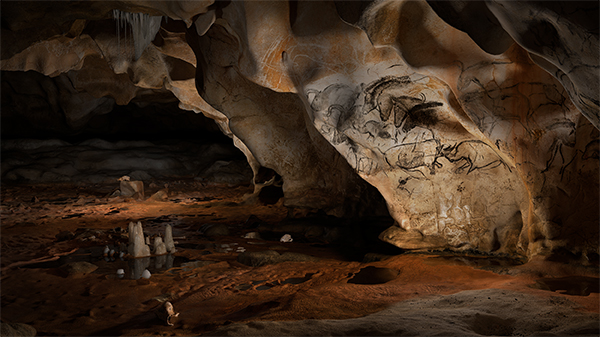
Drawing of lions and a bison in the Chauvet-Pont d’Arc Cave, France. Rup’Art Productions
Ancient humans once painted and engraved images onto the surfaces of caves and their rocky dwellings. This early form of communication, now called “rock art,” enabled prehistoric people to share their ideas and observations of the world, not to mention illustrate their existence within it.
Some of the oldest known and best-preserved rock art is located in the Chauvet-Pont d’Arc Cave in the Ardèche region of southcentral France. Untouched since its entrance was covered in a landslide over 35,000 years ago, the cave was discovered in 1994 and became a UNESCO World Heritage site in 2014. Since its discovery, the cave has been closed to the public for preservation, but the film The Final Passage, which will have its U.S. debut at the Getty Center on December 4, offers an immersive 3D experience of Chauvet.
Martin Marquet, the producer of the film, told us about the new technology used to make The Final Passage, the importance of conserving cultural heritage, and rock art’s enduring legacy in modern street art.
The Final Passage offers an “immersive experience” of the cave. What technology did the filmmakers use?
Considering the restrictions on accessing the original cave, the first thing we thought about was how to create an ultra-realistic and emotional experience of the archeological site on-screen. The film was entirely built from a digital clone of the Chauvet Cave, which was created using 3D laser scan data of the entire cavity and extremely high-definition photography of the paintings. That first model was then enhanced with visual effects to allow us to virtually recreate every “living” aspect of the cave, down to the stalagmites, crystals on the floors, and water drops. This allows the audience to feel like they’re inside the dark and humid atmosphere of an underground space. The environments in these sites are very particular and contribute a lot to the experience of discovery and amazement.

Chauvet-Pont d’Arc Cave, France. Rup’Art Productions
The art discovered in the Chauvet-Pont d’Arc cave is around 35,000 years old, yet the paintings look incredibly fresh and modern. From your perspective, what is the cultural relevance of rock art today?
Through my personal experience exploring prehistoric rock art, I discovered a powerful world of artistic expression that I like to compare to street art today. Rock art truly is our most ancient artistic legacy, and the film is an homage to all of us and our diversity.
The artistic concept of using our environment—a rocky surface or an urban wall—as the canvas is still remarkably valid, alive, and dynamic. Rock art or street art—it’s the link that these arts share with their environment that lead to unique and emotionally charged perceptions of the world.
Talk about the role of your film in raising awareness of areas that are particularly remote or threatened.
Film is one of the most interesting long-term ways of preserving images of our cultural heritage. The films that I produce, including The Final Passage, use a set of cost-effective technical solutions instead of more costly conventional data recording techniques, creating multimedia projects that can reach a wider global audience. Filmmaking and other forms of cultural productions using 3D recording or other kinds of virtual immersions offer much more than an object of pure visual conservation; it creates emotional ways to experience, educate, and share. The Getty Conservation Institute is also an inspiring leader in preserving cultural heritage, which explains my great excitement to be presenting the film for the first time in the U.S. at the Getty Center.
[The Getty Conservation Institute has spearheaded rock art preservation initiatives, including the Southern African Rock Art Project.]What other cultural heritage sites are you interested in filming?
I’m equally interested in recording rock art in aboriginal land in northern Australia as in heritage sites that are currently threatened by geopolitical and armed conflicts, such as in Syria or in the Middle East. Sharing the richness of our universal heritage with future generations through filmmaking and other cinematic projects has become a priority of mine on a larger cultural production program that I have been developing with my colleagues. There is so much more to come, and not just films….
___________
The U.S. premiere screening and a panel discussion of The Final Passage will take place on December 4, 2015, at 7:00 p.m. in the Harold M. Williams Auditorium at the Getty Center. The event is sold out, but information about additional screenings can be found at thefinalpassage.net.




Comments on this post are now closed.